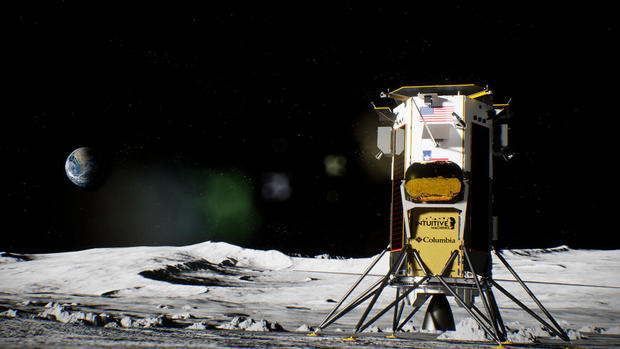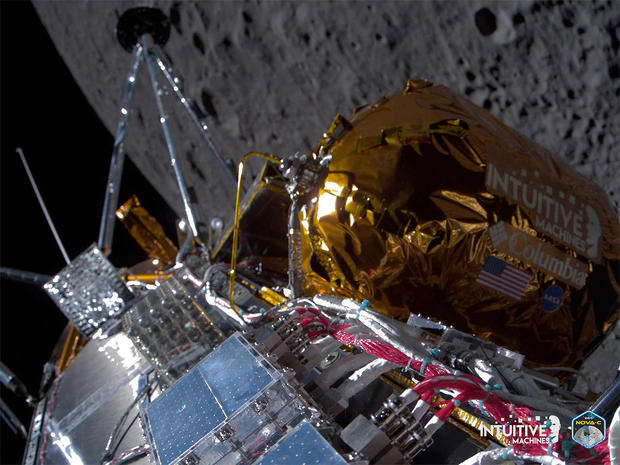First U.S. moon landing since 1972 as private spacecraft touches down on lunar surface
Intuitive Machines' Odysseus lander touched down on the moon Thursday after a historic, nail-biting descent following a last-minute navigation sensor malfunction, becoming the first U.S.-built spacecraft to stick a moon landing in more than 50 years and the first ever by a private company.
After delaying the final descent by one orbit to press an experimental NASA navigation sensor into service — and to test hurriedly-written software patches to route its data to the lander's flight computer — Odysseus settled to a touchdown at 6:23 p.m. EST near a crater known as Malapert A some 186 miles from the south pole of the moon.
Engineers at Intuitive Machines' Nova control center in Houston expected it to take up to two minutes or so to re-establish communications after landing, but the expected signal was not immediately found.
Finally, a faint signal was picked up by a communications antenna in the United Kingdom, indicating the spacecraft had, in fact, survived the touchdown.
"What we can confirm, without a doubt, is our equipment is on the surface of the moon, and we are transmitting," Mission Director Tim Crain told the flight control team. "So congratulations, IM team! We'll see how much more we can get from that."
NASA Administrator Bill Nelson was quick to congratulate Intuitive Machines, SpaceX for the Falcon 9 rocket that launched Odysseus last week from the Kennedy Space Center, and the agency's own commercial moon program, saying they "aced the landing of a lifetime."
"Today, for the first time in more than a half century, the U..S has returned to the moon," he said. "Today, for the first time in the history of humanity, a commercial company, an American company, launched and led the voyage up there. And today is a day that shows the power and promise of NASA's commercial partnerships."
He concluded with, "What a triumph! ... This feat is a giant leap forward for all of humanity."
But a detailed assessment of the health of the spacecraft and its payloads awaited analysis of telemetry. Finally, two hours after touchdown, the company reported that "after troubleshooting communications, flight controllers have confirmed Odysseus is upright and starting to send data. Right now, we are working to downlink the first images from the lunar surface."
The historic descent began one day after Odysseus braked into an orbit tilted 80 degrees to the moon's equator. During its fall toward the surface Thursday, on-board cameras and lasers were programmed to scan the ground below to identify landmarks, providing steering inputs to the lander's guidance system to help fine tune the trajectory.
But those sensors failed to operate properly, prompting Intuitive Machines to switch over to a set of NASA sensors that were on board as a technology demonstration. Those sensors were not intended for use during landing, but as the descent began, engineers reported they were operating properly to provide the needed navigation data.
About 12 minutes before touchdown, the spacecraft's main engine ignited at an altitude of just under 20 miles and a few minutes ater that, Odysseus flipped from a horizontal orientation to vertical, dropping straight down toward the surface.
As the spacecraft dropped below 100 feet, an innovative camera package, known as "EagleCam," built by students at Embry-Riddle Aeronautical University, was intended to fall away and attempt to photograph the lander's final descent from the side. NASA cameras on board the spacecraft will photograph the ground directly below.
By the time Odysseus reached an altitude of about 33 feet above the surface, the main engine was to have throttled down to the planned landing velocity of about 2.2 mph — walking speed for senior citizens. While it took longer than expected to re-establish communications after touchdown, the faint signal picked up in the United Kingdom was a relief.
"We copy you down, Odysseus lander!" the Goonhilly tracking station said on social media. "Congratulations to the @int_machines team and fellow partner organisations - we're 'over the Moon' to have played a part!"
Video from the lander's onboard cameras and the EagleCam could not be transmitted back to Earth in real time. Intuitive Machines' engineers initially said the first pictures were expected within a half hour or so of touchdown, but given the communications issues, those images were expected later.
The successful lunar landing marked the first touchdown by a U.S.-built spacecraft since the Apollo 17 mission in 1972 and the first ever by a privately-built spacecraft.
Pittsburgh-based Astrobotic hoped to claim that honor last month with its Peregrine lander, but the mission was derailed by a ruptured propellant tank shortly after launch Jan. 9. Two earlier private moon ventures, one by Israel and the other by Japan, also ended in failure.
Only the governments of the United States, the Soviet Union, China, India and Japan have successfully put landers on the surface of the moon, and Japan's "SLIM" lander was only partially successful, tipping over on touchdown Jan. 19.
Peregrine and Odysseus were both funded in part by NASA's Commercial Lunar Payload Services program, or CLPS (pronounced "clips"), designed to encourage private industry to develop transportation capabilities that NASA can then use to transport payloads to the moon.
The agency's goal is to help kickstart development of new technologies and to collect data that will be needed by Artemis astronauts planning to land near the moon's south pole later this decade.
NASA paid Astrobotic $108 million for its part in the Peregrine mission and another $129 million for the Odysseus instruments and transportation to the moon.
What's on board the Odysseus moon lander?
Odysseus was equipped with six NASA instruments and another six commercial payloads, including small moon sculptures by the artist Jeff Koons, proof-of-concept cloud storage technology, Columbia Sportswear insulation blankets and a small astronomical telescope.
Among the NASA experiments: an instrument to study the charged particle environment at the moon's surface, the navigation technology demonstration and the downward-facing cameras designed to photograph how the lander's engine exhaust disrupts the soil at the landing site.
Also on board: an innovative sensor using radio waves to accurately determine how much cryogenic propellant is left in a tank in the weightless environment of space, technology expected to prove useful for downstream moon missions and other deep space voyages.
Odysseus and its instruments are expected to operate on the surface for about a week, until the sun sets at the landing site. At that point, the lander's solar cells will no longer be able to generate power and the spacecraft will shut down. Odysseus was not designed to survive the ultra-cold lunar night.






